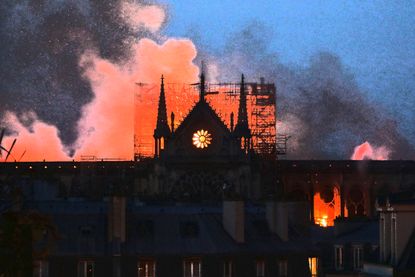What Notre Dame means to Catholics
For us, it was lost long ago


It was early in the afternoon of Monday in Holy Week, as John Carol Case was singing the "Was wollt ihr mir geben?" of Judas on my turntable, that I first saw the images of Notre-Dame de Paris burning. A few minutes earlier I had silently said a prayer for a few friends at the University of Notre Dame some 50 miles from me in South Bend, Indiana. It had not occurred to me when I saw a message announcing that a fire had broken at "Notre Dame" that the journalist meant the cathedral church of the Archdiocese of Paris, begun around the year of Our Lord 1160 and completed, if such buildings are ever really finished, nearly 200 years later.
I ought to have known better. The edifice has survived wars and revolutions and restoration projects whose advisability varied. That she might disappear, in whole or in part, from the face of the city with whom she is rightly synonymous had simply never occurred to me.
I can, I suppose, just about imagine how millions of non-Catholics, both in France and abroad, will have greeted the news. How sad that this "landmark," this tourist attraction, this revered example of French Gothic architecture was destroyed.
Subscribe to The Week
Escape your echo chamber. Get the facts behind the news, plus analysis from multiple perspectives.

Sign up for The Week's Free Newsletters
From our morning news briefing to a weekly Good News Newsletter, get the best of The Week delivered directly to your inbox.
From our morning news briefing to a weekly Good News Newsletter, get the best of The Week delivered directly to your inbox.
But for many of us it was a rather different sort of symbol, almost indescribably fitting, of something that took place long ago — the almost total collapse of the Catholic religion in the nation that once proudly referred to herself as the "Church's eldest daughter." The interior of the Church was gutted in the Revolution of 1789. For the next century and a half, Catholics, especially those in religious life, suffered under various civil penalties. Today only some 7 percent of French people attend Mass weekly. Notre-Dame was a ghost, a more or less accidental holdover from a Christendom that burned in the conflagrations of many centuries past. It was that great American agnostic Henry Adams who put it best:
Of all the elaborate symbolism which has been suggested for the Gothic cathedral, the most vital and most perfect may be that the slender nervure, the springing motion of the broken arch, the leap downwards of the flying buttress — the visible effort to throw off a visible strain — never let us forget that Faith alone supports it, and that, if Faith fails, Heaven is lost. The equilibrium is visibly delicate beyond the line of safety; danger lurks in every stone. The peril of the heavy tower, of the restless vault, of the vagrant buttress; the uncertainty of logic, the inequalities of the syllogism, the irregularities of the mental mirror — all these haunting nightmares of the Church are expressed as strongly by the Gothic cathedral as though it had been the cry of human suffering, and as no emotion had ever been expressed before or is likely to find expression again. The delight of its aspirations is flung up to the sky. The pathos of its self-distrust and anguish of doubt is buried in the earth as its last secret. You can read out of it whatever else pleases your youth and confidence; to me, this is all. [Henry Adams]
For many the faith was surely lost long ago and Heaven with it. Notre-Dame had all but outlived her usefulness as a church. This is what I found myself thinking as I lit a candle to St. Jude, the patron of lost causes, on Monday afternoon. A few hours later it was reported that the relics of Notre Dame — chief among them the gold-encased fragments from the Crown of Thorns — had been saved. Then I began to understand.
Nearly two-thousand years ago in a minor Roman province a child was born. No one noticed, save for a few members of what we would now call the "rural poor" and a trio of mystics from the Far East. This child grew to a man and did extraordinary things — indeed, things that were and remain utterly inconceivable. The blind saw. Loaves were multiplied and thousands ate. Sufferers from Hansen's disease and other serious illnesses were cured. Men rose from the dead. It soon became clear to a handful of people that the man's cousin, who had himself been murdered under horrifying circumstances by the leader of the provincial puppet government, had been right, and that He was the king whose birth had been long foretold. But His kingship was unlike anything anyone expected, least of all those who had prayed for it. One day He rode triumphantly into Jerusalem, the holy city of his people. Soon thereafter, He was betrayed by one of his followers, given over to the religious and then the secular authorities, and subjected to judicial torture and, eventually, execution.
If this were the end of the story, it would be remembered by almost no one. But the story did not end there. The female friends of the murdered man visited His tomb and found it empty. He then rejoined them for a brief period of time, during which he spoke to them about the true nature of His kingdom. Finally He was taken up into the heavens.
In its bare outline, some of this story belongs to history — to Tacitus and Josephus and so on — but in many crucial respects we have no source save the records of it made and passed down by members of that primitive society of believers. Here are mysteries both within and utterly outside the bounds of history — whispers of a final victory over sin, death, and darkness that would be raised over the course of the centuries to a univocal cry across much of the world. Once more this cry has become a low whisper, a watch-word of eccentrics and fanatics and enthusiasts. An increasingly large number of them live outside the so-called "developed" world.
As a symbol of the French Republic, as a tourist attraction, as an image of what morons and conservatives call "Western civilization," Notre-Dame is nothing. Disney could rebuild it and market it as a tourist attraction — the live-action Hunchback experience, complete with talking animatronic gargoyles. As the seat of a successor of the friends of the man killed by the Romans so many ages ago, and a place where those who keep their inheritance meet to witness the celebration of certain mysteries at His command, it lived. It lived for centuries and was alive still decades ago when the displaced Archbishop Pierre Martin Ngô Đình Thục, the brother of the assassinated president of Vietnam, sat in her ancient confessionals hearing the sins of penitents — himself a kind of ghost. It will, in some form or other, continue to live for many years hence.
In the ashes of Paris, where a wooden spire that dated from no later than the 19th century once leapt toward the heavens, there is hope. It is the hope of the more than one billion members of His mystical body who await Sunday. If the relevant authorities are to be believed, the interior of Notre-Dame will be empty on Easter.
So was the tomb two millennia ago.
Sign up for Today's Best Articles in your inbox
A free daily email with the biggest news stories of the day – and the best features from TheWeek.com
Matthew Walther is a national correspondent at The Week. His work has also appeared in First Things, The Spectator of London, The Catholic Herald, National Review, and other publications. He is currently writing a biography of the Rev. Montague Summers. He is also a Robert Novak Journalism Fellow.
-
 Band Aid 40: time to change the tune?
Band Aid 40: time to change the tune?In the Spotlight Band Aid's massively popular 1984 hit raised around £8m for famine relief in Ethiopia and the charity has generated over £140m in total
By Rebekah Evans, The Week UK Published
-
 Starmer vs the farmers: who will win?
Starmer vs the farmers: who will win?Today's Big Question As farmers and rural groups descend on Westminster to protest at tax changes, parallels have been drawn with the miners' strike 40 years ago
By The Week UK Published
-
 How secure are royal palaces?
How secure are royal palaces?The Explainer Royal family's safety is back in the spotlight after the latest security breach at Windsor
By Chas Newkey-Burden, The Week UK Published